+ Open data
Open data
- Basic information
Basic information
| Entry | Database: PDB / ID: 6t4p | ||||||
|---|---|---|---|---|---|---|---|
| Title | Human Carbonic anhydrase II bound by napthalene-1-sulfonamide | ||||||
 Components Components | carbonic anhydrase 2 | ||||||
 Keywords Keywords | LYASE / drug design / carbonic anhydrase / benzenesulfonamide / metal-binding / lyase-lyase inhibitor complex | ||||||
| Function / homology |  Function and homology information Function and homology informationpositive regulation of cellular pH reduction / positive regulation of dipeptide transmembrane transport / regulation of monoatomic anion transport / secretion / cyanamide hydratase activity / cyanamide hydratase / arylesterase activity / regulation of chloride transport / Reversible hydration of carbon dioxide / morphogenesis of an epithelium ...positive regulation of cellular pH reduction / positive regulation of dipeptide transmembrane transport / regulation of monoatomic anion transport / secretion / cyanamide hydratase activity / cyanamide hydratase / arylesterase activity / regulation of chloride transport / Reversible hydration of carbon dioxide / morphogenesis of an epithelium / angiotensin-activated signaling pathway / positive regulation of synaptic transmission, GABAergic / regulation of intracellular pH / carbonic anhydrase / carbonate dehydratase activity / carbon dioxide transport / Erythrocytes take up oxygen and release carbon dioxide / Erythrocytes take up carbon dioxide and release oxygen / neuron cellular homeostasis / apical part of cell / myelin sheath / extracellular exosome / zinc ion binding / plasma membrane / cytoplasm / cytosol Similarity search - Function | ||||||
| Biological species |  Homo sapiens (human) Homo sapiens (human) | ||||||
| Method |  X-RAY DIFFRACTION / X-RAY DIFFRACTION /  SYNCHROTRON / SYNCHROTRON /  MOLECULAR REPLACEMENT / Resolution: 1.75 Å MOLECULAR REPLACEMENT / Resolution: 1.75 Å | ||||||
 Authors Authors | Smirnov, A. / Manakova, E. / Grazulis, S. | ||||||
 Citation Citation |  Journal: Biophys.J. / Year: 2020 Journal: Biophys.J. / Year: 2020Title: Isoform-Selective Enzyme Inhibitors by Exploring Pocket Size According to the Lock-and-Key Principle. Authors: Dudutiene, V. / Zubriene, A. / Kairys, V. / Smirnov, A. / Smirnoviene, J. / Leitans, J. / Kazaks, A. / Tars, K. / Manakova, L. / Grazulis, S. / Matulis, D. | ||||||
| History |
|
- Structure visualization
Structure visualization
| Structure viewer | Molecule:  Molmil Molmil Jmol/JSmol Jmol/JSmol |
|---|
- Downloads & links
Downloads & links
- Download
Download
| PDBx/mmCIF format |  6t4p.cif.gz 6t4p.cif.gz | 74.5 KB | Display |  PDBx/mmCIF format PDBx/mmCIF format |
|---|---|---|---|---|
| PDB format |  pdb6t4p.ent.gz pdb6t4p.ent.gz | 52.6 KB | Display |  PDB format PDB format |
| PDBx/mmJSON format |  6t4p.json.gz 6t4p.json.gz | Tree view |  PDBx/mmJSON format PDBx/mmJSON format | |
| Others |  Other downloads Other downloads |
-Validation report
| Summary document |  6t4p_validation.pdf.gz 6t4p_validation.pdf.gz | 789.7 KB | Display |  wwPDB validaton report wwPDB validaton report |
|---|---|---|---|---|
| Full document |  6t4p_full_validation.pdf.gz 6t4p_full_validation.pdf.gz | 790.8 KB | Display | |
| Data in XML |  6t4p_validation.xml.gz 6t4p_validation.xml.gz | 14.7 KB | Display | |
| Data in CIF |  6t4p_validation.cif.gz 6t4p_validation.cif.gz | 21.6 KB | Display | |
| Arichive directory |  https://data.pdbj.org/pub/pdb/validation_reports/t4/6t4p https://data.pdbj.org/pub/pdb/validation_reports/t4/6t4p ftp://data.pdbj.org/pub/pdb/validation_reports/t4/6t4p ftp://data.pdbj.org/pub/pdb/validation_reports/t4/6t4p | HTTPS FTP |
-Related structure data
| Related structure data | 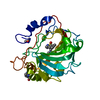 6t4nC 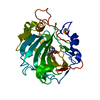 6t4oC 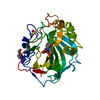 6t5cC 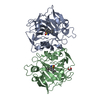 6t5pC 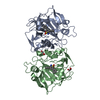 6t5qC 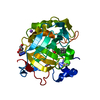 6t81C 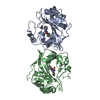 6tl5C 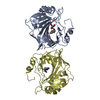 6tl6C 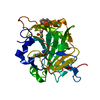 4ht0S C: citing same article ( S: Starting model for refinement |
|---|---|
| Similar structure data |
- Links
Links
- Assembly
Assembly
| Deposited unit | 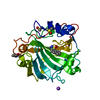
| ||||||||
|---|---|---|---|---|---|---|---|---|---|
| 1 |
| ||||||||
| Unit cell |
|
- Components
Components
-Protein , 1 types, 1 molecules A
| #1: Protein | Mass: 29289.062 Da / Num. of mol.: 1 / Fragment: Human Carbonic anhydrase II Source method: isolated from a genetically manipulated source Source: (gene. exp.)  Homo sapiens (human) / Plasmid: pET15b / Production host: Homo sapiens (human) / Plasmid: pET15b / Production host:  |
|---|
-Non-polymers , 6 types, 253 molecules 
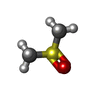
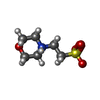








| #2: Chemical | ChemComp-ZN / | ||||||||
|---|---|---|---|---|---|---|---|---|---|
| #3: Chemical | | #4: Chemical | ChemComp-MES / | #5: Chemical | ChemComp-MHK / | #6: Chemical | ChemComp-NA / | #7: Water | ChemComp-HOH / | |
-Details
| Has ligand of interest | Y |
|---|
-Experimental details
-Experiment
| Experiment | Method:  X-RAY DIFFRACTION / Number of used crystals: 1 X-RAY DIFFRACTION / Number of used crystals: 1 |
|---|
- Sample preparation
Sample preparation
| Crystal | Density Matthews: 2.06 Å3/Da / Density % sol: 40.17 % |
|---|---|
| Crystal grow | Temperature: 291 K / Method: vapor diffusion, sitting drop Details: Crystallization buffer was 0.1M sodium BICINE, pH 9, and 2M sodium malonate pH 7 made from 1M sodium BICINE and 3.4M sodium malonate |
-Data collection
| Diffraction | Mean temperature: 100 K / Serial crystal experiment: N | |||||||||||||||||||||||||||||||||||||||||||||||||||||||||||||||||||||||||||||||||||||||||||||||||||||||||||||||||||||||||
|---|---|---|---|---|---|---|---|---|---|---|---|---|---|---|---|---|---|---|---|---|---|---|---|---|---|---|---|---|---|---|---|---|---|---|---|---|---|---|---|---|---|---|---|---|---|---|---|---|---|---|---|---|---|---|---|---|---|---|---|---|---|---|---|---|---|---|---|---|---|---|---|---|---|---|---|---|---|---|---|---|---|---|---|---|---|---|---|---|---|---|---|---|---|---|---|---|---|---|---|---|---|---|---|---|---|---|---|---|---|---|---|---|---|---|---|---|---|---|---|---|---|---|
| Diffraction source | Source:  SYNCHROTRON / Site: SYNCHROTRON / Site:  EMBL/DESY, HAMBURG EMBL/DESY, HAMBURG  / Beamline: X11 / Wavelength: 0.815 Å / Beamline: X11 / Wavelength: 0.815 Å | |||||||||||||||||||||||||||||||||||||||||||||||||||||||||||||||||||||||||||||||||||||||||||||||||||||||||||||||||||||||||
| Detector | Type: MAR555 FLAT PANEL / Detector: IMAGE PLATE / Date: Nov 19, 2011 | |||||||||||||||||||||||||||||||||||||||||||||||||||||||||||||||||||||||||||||||||||||||||||||||||||||||||||||||||||||||||
| Radiation | Protocol: SINGLE WAVELENGTH / Monochromatic (M) / Laue (L): M / Scattering type: x-ray | |||||||||||||||||||||||||||||||||||||||||||||||||||||||||||||||||||||||||||||||||||||||||||||||||||||||||||||||||||||||||
| Radiation wavelength | Wavelength: 0.815 Å / Relative weight: 1 | |||||||||||||||||||||||||||||||||||||||||||||||||||||||||||||||||||||||||||||||||||||||||||||||||||||||||||||||||||||||||
| Reflection | Resolution: 1.75→31.96 Å / Num. all: 23997 / Num. obs: 23997 / % possible obs: 98.9 % / Redundancy: 6.8 % / Rmerge(I) obs: 0.071 / Rpim(I) all: 0.031 / Rrim(I) all: 0.081 / Rsym value: 0.071 / Net I/av σ(I): 7.3 / Net I/σ(I): 23.3 / Num. measured all: 163532 | |||||||||||||||||||||||||||||||||||||||||||||||||||||||||||||||||||||||||||||||||||||||||||||||||||||||||||||||||||||||||
| Reflection shell | Diffraction-ID: 1
|
- Processing
Processing
| Software |
| |||||||||||||||||||||||||||||||||||||||||||||
|---|---|---|---|---|---|---|---|---|---|---|---|---|---|---|---|---|---|---|---|---|---|---|---|---|---|---|---|---|---|---|---|---|---|---|---|---|---|---|---|---|---|---|---|---|---|---|
| Refinement | Method to determine structure:  MOLECULAR REPLACEMENT MOLECULAR REPLACEMENTStarting model: 4HT0 Resolution: 1.75→26.57 Å / Cor.coef. Fo:Fc: 0.958 / Cor.coef. Fo:Fc free: 0.942 / Cross valid method: THROUGHOUT / σ(F): 0 / ESU R: 0.128 / ESU R Free: 0.119 Details: HYDROGENS HAVE BEEN USED IF PRESENT IN THE INPUT U VALUES : REFINED INDIVIDUALLY
| |||||||||||||||||||||||||||||||||||||||||||||
| Solvent computation | Ion probe radii: 0.8 Å / Shrinkage radii: 0.8 Å / VDW probe radii: 1.4 Å | |||||||||||||||||||||||||||||||||||||||||||||
| Displacement parameters | Biso max: 62.89 Å2 / Biso mean: 16.051 Å2 / Biso min: 4.84 Å2
| |||||||||||||||||||||||||||||||||||||||||||||
| Refinement step | Cycle: final / Resolution: 1.75→26.57 Å
| |||||||||||||||||||||||||||||||||||||||||||||
| Refine LS restraints |
| |||||||||||||||||||||||||||||||||||||||||||||
| LS refinement shell | Resolution: 1.75→1.795 Å / Rfactor Rfree error: 0 / Total num. of bins used: 20
|
 Movie
Movie Controller
Controller



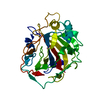
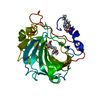
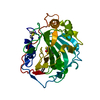
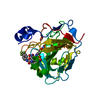
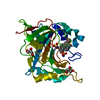
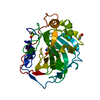
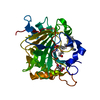
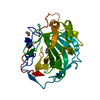
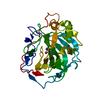
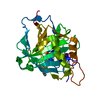


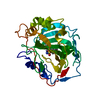
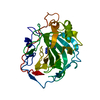
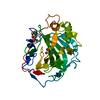
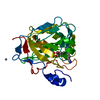
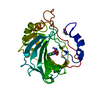
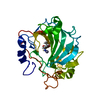
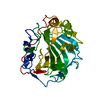
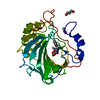
 PDBj
PDBj






